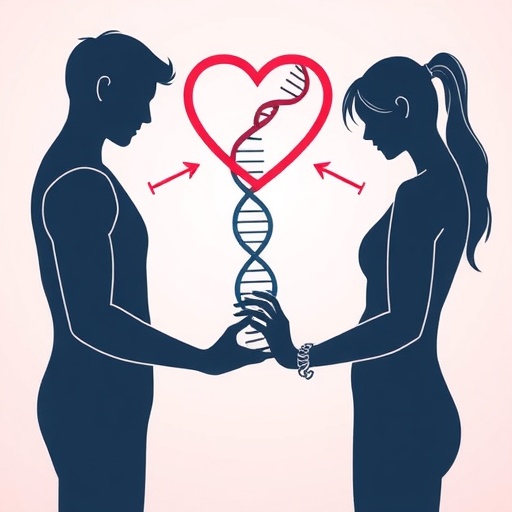In a groundbreaking study, researchers led by C.L. Malone have unveiled compelling insights into the role of sex differences in the expression of mRNA relating to both structure and receptors within the ventral anterior cingulate cortex (vACC). This research not only delves into the neurobiological factors underpinning monogamous pair bonding but also highlights how perineuronal nets may influence the neural pathways associated with these bonds in the species Peromyscus californicus, commonly known as the California mouse.
The ventral anterior cingulate cortex is a key region in the brain that contributes to emotional regulation and social behaviors. Traditionally, this area has been understood primarily through a lens of its involvement in anxiety and depression. Yet, the comprehensive analysis presented by Malone and colleagues shifts the focus toward its distinct functionalities in fostering interpersonal connections, particularly in monogamous species. Unlike many mammals, Peromyscus californicus exhibits a unique commitment to pair bonding, making it an ideal candidate for this investigation.
Within the vACC, there are notable sex differences evident in both the structural makeup and the receptor mRNA expression. The study meticulously documents these variances, illustrating how males and females may engage with the neural substrates of bonding in fundamentally different ways. These differences suggest tailored pathways through which each sex experiences and maintains social affiliations, with potential implications for understanding broader patterns of social behavior in mammals.
Importantly, the research touches upon the presence of perineuronal nets, specialized extracellular matrix structures that envelop certain neurons. These nets play a critical role in stabilizing neural circuits and are especially pertinent to synaptic plasticity—essential for learning and memory. The study posits that perineuronal nets contribute to the establishment and maintenance of pair bonds, acting as modulators of the neural circuitry involved in bonding practices. The findings indicate that variations in the density and distribution of these nets may correlate with the quality of the social relationships formed by the California mouse.
By utilizing advanced techniques in molecular biology and neuroanatomy, the researchers meticulously quantified mRNA levels corresponding to various receptors in the vACC. They harnessed techniques such as in situ hybridization to accurately visualize the expression patterns of these critical genetic markers. The results show significant sexual dimorphism in receptor expression that may elucidate the underlying neurobiological mechanisms that dictate the differences in behavior associated with monogamous pairing.
Moreover, this study contributes to the growing body of literature that seeks to unravel the complex interplay between biology and behavior in social animals. It underscores the need to appreciate how biological structures can influence behavioral outcomes, particularly in the context of monogamous relationships where long-term social investment is crucial. As we probe deeper into the neurobiological underpinnings of behavior, the implications extend beyond just Peromyscus californicus. They invite speculation on how such mechanisms might generalize to understanding the subtleties of human social relationships as well.
The findings urge us to reconsider not only gender roles within the animal kingdom but also the evolutionary significance of such adaptations. The sex differences observed in receptor expression may offer insights into evolutionary pressures that have shaped social structures and mating strategies over millennia. By understanding these foundational biological processes, science can begin to decode the intricate dance of attraction, intimacy, and companionship observed across species.
Furthermore, the research delineates how these findings might inform future studies on stress responses and social behaviors more broadly. Stress can significantly alter social behaviors, and understanding the biological roots of pair bonding could prove essential in addressing mental health issues related to social isolation or relationship dynamics in both humans and animals. Given that the ventral anterior cingulate cortex is associated with the regulation of emotional responses to stress, this line of inquiry may open up new avenues for therapeutic interventions.
As we delve further into intricate animal behaviors, utilizing species known for distinct bonding patterns provides a framework for establishing links between molecular biology and behavioral science. This study marks a pivotal step in unraveling the biological complexities inherent in social organisms, revealing how nuanced variations at the genetic level can impact social behavior and relationship dynamics.
The implications of this research extend into realms such as ecological and evolutionary biology, where understanding the complexities of sociality can inform conservation efforts. As habitats change and species adapt, insights into the mechanisms driving social behaviors may help in developing strategies to foster stability in ecosystems, emphasizing the importance of social bonds within populations.
In conclusion, the work by Malone and her team not only sheds light on the molecular and structural differences in mRNA expression in the vACC of Peromyscus californicus, but it also provides a compelling narrative about the evolutionary significance of these findings. The interplay between biology and behavior illustrates a promising frontier for future research, poised to enhance our understanding of the biological and evolutionary frameworks that shape social behavior in a wide array of species.
This groundbreaking study opens doors for more extensive examinations into the broader implications of these biological differences. Future research will likely build upon these findings, exploring the functional consequences of divergent neural pathways and how they relate to the stability and quality of interpersonal relationships across different species.
Subject of Research: The role of sex differences in structural and receptor mRNA expression in the ventral anterior cingulate cortex in relation to pair bonding in Peromyscus californicus.
Article Title: Sex differences in structural and receptor mRNA expression in the ventral anterior cingulate cortex and a potential role of perineuronal nets in monogamous pair bond establishment.
Article References:
Malone, C.L., Li, J., Luebke, E.M. et al. Sex differences in structural and receptor mRNA expression in the ventral anterior cingulate cortex and a potential role of perineuronal nets in monogamous pair bond establishment (Peromyscus californicus). Biol Sex Differ 16, 58 (2025). https://doi.org/10.1186/s13293-025-00741-4
Image Credits: AI Generated
DOI: 10.1186/s13293-025-00741-4
Keywords: Sex differences, mRNA expression, ventral anterior cingulate cortex, perineuronal nets, monogamous pair bonding, Peromyscus californicus.




